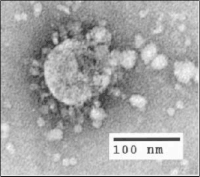
Photo from wikipedia
Background: The transmission of respiratory viruses such as influenza and corona viruses from one person to another is still not fully understood. Methods: A literature search showed that there is… Click to show full abstract
Background: The transmission of respiratory viruses such as influenza and corona viruses from one person to another is still not fully understood. Methods: A literature search showed that there is a strong scientific rationale and evidence that viruses are very efficiently spread through aerosols by the patient's breathing only. It is not necessary for the patient to cough or sneeze. Results: The exhaled aerosol particles are generated by normal breathing in the deep lung through reopening of collapsed small airways during inspiration. These mucus/surfactant aerosols (size range between 0.2 and 0.6 μm) can transport viruses out of the lungs of patients and be present in the room air for hours. Conclusion: These aerosol particles are difficult to filter out of the air; because of their physical properties, new strategies must be developed to protect people from these virus aerosols.
Journal Title: Journal of Aerosol Medicine and Pulmonary Drug Delivery
Year Published: 2020
Link to full text (if available)
Share on Social Media: Sign Up to like & get
recommendations!